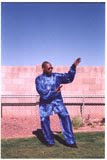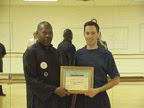For the beginning martial artist my tips for the year are:
- Spend some time at a few different schools to get a sense of your comfort with one school and system over the other.
- Ask questions and see how you are treated.
- Look for a price range that you can manage so you can continue once you start.
- Learn the basic stances, punches, kicks, blocks, and movements of your new system and never stop practicing them. Over time they will reveal things to you that you did not see before and they will strengthen all of your advanced movements and techniques.
- Learn your teacher's system of Qigong (breathing exercises) and practice Qigong diligently. It will improve your health, internal strength, vitality, and power (and much more).
- Make sure that you enroll in a Traditional Martial and Healing Arts Program so that you are exposed to all of the character building wisdom of the culture and tradition from which you system was developed.
- Pay attention to details! In the martial arts, details matter!
- Make a training schedule or calendar to keep you on engaged and focused on your process. Being a martial artist is not just about what you do; it is also about who you are becoming.
- If you are a parent (or not) you might decide to read Wu-Te: A Guide to Parents – Why Teach Your Children The Traditional Martial & Healing Arts? (Preview in separate window)
For the aging martial artist my tips for the year are:
- Strive to review all of what you know cyclically, once per month, quarter, biannually, or annually.
- Soften the wood! That means allow yourself to become more flexible, unorthodox in how you execute your techniques.
- Continue to perform every movement of your everyday life as if it were a martial movement. (Sweeping the floor, getting something out of a cabinet, getting in and out of the car).
- Stretch! Stretch! Stretch! Some of us are naturally flexible and some of us are as stiff as dry wood. But dry wood can be softened. Stretching is a way of soaking the aging wood of your body so that it maintains or enhances softness and pliability.
- Practice some form of Qigong every day!
- Eat to Live! Don’t live to Eat! Reassess your dietary habits to make sure that they are consistent with how your body is working at your present age.
- Teach someone!
If you are a martial artist who falls somewhere in between beginner and aging then my tips to you for the year are simple:
- Train like you are a beginner, always practicing your basics.
- Train in anticipation of becoming an aging martial artist.
- Taking your training seriously
- Paying attention to details
- Being diligent in your practice
- Choosing good training partners
- Choosing a system and style that is best suited to your personality and body type
- Choosing a good Traditional Martial & Healing Arts teacher
Have a safe, fun, and productive year of training!
Live Wu-Te
Seifu Sharif


